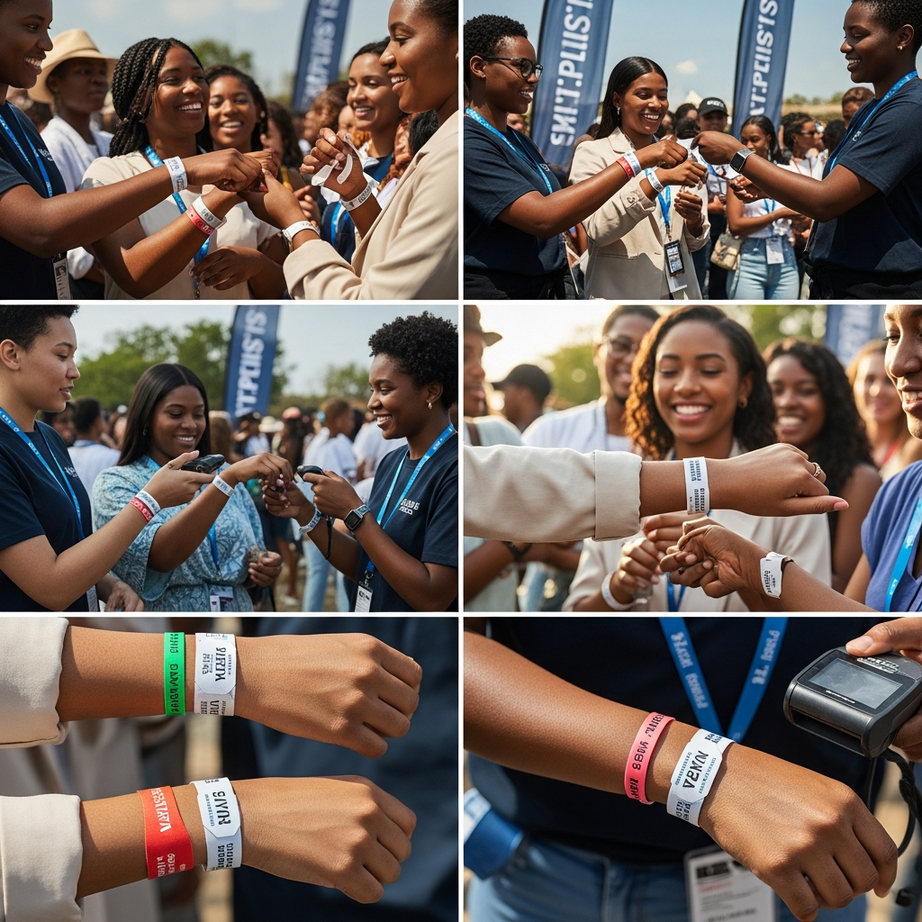Understanding Silicone Material
What Is Silicone?
Silicone is a flexible, synthetic material that looks and feels a lot like rubber. It’s made from silica, which is a natural mineral found in sand and rock. Manufacturers turn this mineral into a gel-like substance through a process involving heat and pressure. Once the material has been formed, it can be shaped into many things, but it’s especially popular for making wristbands. The reason for this is simple. Silicone is soft to the touch, comfortable to wear, and it holds up very well over time, even if you use it every day.
How Silicone Is Manufactured
To make silicone wristbands, manufacturers start with raw silicone pellets. These are mixed with colouring agents, usually based on the exact shade a customer wants. Once the colour is set, the mixture is put into a mould. High heat and pressure are applied, causing the silicone to take the shape of the mould. After a short curing period, the wristbands are removed, trimmed, and checked to make sure they meet the required standards. This process is fast, efficient, and produces consistent results. Because silicone is easy to shape, wristbands can be made in different sizes, colours, and even with unique designs.
Why Silicone Is Suitable for Wristbands
There are several reasons why silicone works so well for wristbands. The material is durable, so it doesn’t crack or break easily. It stretches without losing its shape and doesn’t get damaged by water or sweat. Silicone is also non-toxic and hypoallergenic, which means it doesn’t irritate the skin, even if worn for long periods. These qualities make it a first choice for wristbands used by children and adults alike, whether at events, in schools, or for health purposes.
Features of Silicone Wristbands
Durability and Longevity
One of the main reasons people choose silicone wristbands is that they last a long time. They don’t fade or wear out quickly, even if exposed to sunlight or water. Silicone resists tearing and can survive daily use in a range of conditions, from sport to swimming pools. Many users keep their wristbands for months, sometimes even years, without noticing much change in how they look or feel.
Waterproof and Sweat-Resistant Properties
A standout feature of silicone is that it doesn’t absorb water. This makes silicone wristbands perfect for use in the rain, at the beach, or while working out. Sweat simply rolls off the surface, so the band doesn’t become sticky or slippery. This is a big advantage over fabric or paper wristbands, which can quickly get soggy and uncomfortable.
Comfort and Skin-Friendliness
Comfort is always a concern for something you wear on your skin all day. Silicone wristbands are smooth and flexible, so they adapt easily to your wrist shape. They don’t dig in or cause rashes, which is important for children or people with sensitive skin. Since silicone is hypoallergenic, it rarely causes any reaction, making it a safe option for most people.
Eco-Friendly Aspects
While silicone is not biodegradable, it does last a very long time, reducing the need for frequent replacement. Some manufacturers have also started to use more sustainable practices, recycling old silicone products into new wristbands. This cuts down on waste and helps keep products out of landfills. Silicone doesn’t leach harmful chemicals, which is another reason it’s trusted for health and safety uses.
Common Uses of Silicone Wristbands
Promotional and Branding Purposes
Silicone wristbands have become a favourite tool for promotions. They are small, light, and easy to hand out at events. Many businesses use them to promote their name, logo, or a message. Because wristbands are worn on the arm, the branding stays visible all day. This creates a strong, lasting impression, whether used at product launches, trade shows, or community events.
Awareness Campaigns and Charitable Causes
Silicone wristbands are well-known for supporting social causes. From health awareness to anti-bullying campaigns, these bands send a message without saying a word. The colour of the wristband often signals the cause, like pink for breast cancer or red for HIV support. Because they’re affordable and easy to customise, many groups use wristbands to raise funds and start conversations about important topics.
Event Access Control and Identification
At big events, silicone wristbands help manage crowds and control access. They are hard to remove without cutting, making them a secure option for festivals, sports matches, or conferences. Different colours can be used to show which areas a person can enter, which makes security checks quick and simple. Unlike paper wristbands, silicone options don’t tear or get ruined by water, so they last for the whole event.
Medical and Allergy Information
Some people wear silicone wristbands to share critical health information. For example, a child with a peanut allergy may wear a band that says so, which helps teachers or caregivers react quickly if needed. Medical wristbands can also carry emergency contact numbers or details about conditions like epilepsy or diabetes. This can be life-saving when the wearer can’t speak for themselves.
Fashion and Personal Expression
For many, silicone wristbands are just a fun way to show off personality. Bands come in all sorts of colours and can be printed with anything from motivational quotes to favourite song lyrics. Friends often swap wristbands as a sign of friendship or belonging to a group. The fashion aspect is especially popular with young people, who collect different bands and wear them in stacks.
Design and Customisation Options
Available Sizes for Adults and Children
Silicone wristbands aren’t one-size-fits-all. There are standard sizes for adults and smaller versions for children. Some bands are wide, while others are slim and barely noticeable. This range allows people to choose the style and fit that feels right for them. Because silicone is stretchy, each size can fit a range of wrist shapes.
Colour Choices and Pantone Matching
Colour is one of the first things people notice about a wristband. Silicone can be made in almost any shade, from bold primaries to subtle pastels. Some manufacturers use Pantone matching, which means the colour is exactly what the customer asks for. Wristbands can be made in a single colour, two or more colours swirled together, or even stripes. This flexibility allows for creativity, making each wristband unique to its purpose.
Printing Techniques: Screen Printing, Embossed, Debossed, Colour Fill
Designs and messages are added to silicone wristbands using different techniques. Screen printing puts ink directly on the band’s surface, which works well for logos or slogans. Embossed bands have raised letters or shapes, giving a three-dimensional look. Debossed bands have letters pressed into the silicone, which can then be filled with colour for extra contrast. Each method creates a different feel and helps the message stand out.
Special Features: Glow-in-the-Dark, UV Reactive, Multi-Coloured Bands
Some silicone wristbands go beyond the basics. Glow-in-the-dark bands light up at night, making them perfect for parties or night events. UV reactive bands change colour in sunlight, adding an element of surprise. Bands can be made with multiple colours swirled or layered, creating a unique look every time. These features make wristbands more appealing and fun to wear.
Custom Shapes and Unique Designs
Silicone wristbands don’t have to be round or flat. They can be moulded into custom shapes, such as stars, hearts, or even animal figures. Some wristbands include detachable pieces, charms, or built-in clasps. These custom touches add to their appeal and make them stand out from regular wristbands.
Manufacturing Process of Silicone Wristbands
Selection of Raw Materials
Making a high-quality wristband starts with pure, food-grade silicone. This ensures the band is safe for skin contact. Colouring agents are carefully measured and mixed with the silicone pellets before the moulding process starts.
Mixing and Colouring Procedures
The raw silicone is blended with colour in large machines, ensuring the shade is consistent throughout. For bands that need more than one colour, separate batches are mixed and then combined in a controlled way to get the right swirl or segment effect.
Moulding and Curing Steps
Once mixed, the silicone goes into wristband-shaped moulds. The moulds are heated under pressure, which causes the silicone to set into shape. Curing time depends on the thickness and style of the wristband. Once cured, the bands are cooled, trimmed, and checked for any defects.
Quality Control and Packaging
Every batch of wristbands is inspected for colour, shape, and finish. Bands that don’t meet the standards are set aside and recycled if possible. The finished wristbands are counted, packed, and prepared for delivery. Some go into plain packaging, while others are grouped on cards or in bags for easy distribution.
Caring for Silicone Wristbands
Cleaning Methods for Daily Maintenance
Keeping a silicone wristband clean is simple. Most of the time, you can just wash it with soap and water. Rinse off dirt and sweat, then let it air dry. If the band picks up any smells, a quick soak in a mix of water and a little vinegar can help.
Removing Stains and Odours
For stubborn stains, use a soft brush and mild soap. Avoid harsh chemicals or scrubbing too hard, as this can damage the printing. If a wristband has a strong smell, leave it in a mix of baking soda and water overnight. This helps absorb any lingering odours.
Proper Storage to Maintain Shape and Colour
When not wearing the wristband, keep it out of direct sunlight to prevent fading. Store it in a cool, dry place to keep the silicone from getting brittle. Avoid storing bands while wet, as trapped moisture can cause mildew or a musty smell.
Limitations and Considerations
Situations Where Silicone May Not Be Ideal
While silicone wristbands are practical for most uses, there are situations where other materials might be better. For example, in some work environments where the wristband could get caught in machinery, silicone might not be allowed for safety reasons. Some people also find that silicone bands can collect dust or lint, especially in dry conditions.
Common Misconceptions About Silicone Wristbands
A common myth is that silicone wristbands are uncomfortable or make your skin sweat. This usually happens only if the band is too tight or worn in hot weather for long periods. Some people believe all silicone bands are the same, but quality varies a lot depending on how they are made. Low-quality bands can snap or lose their colour quickly.
Comparing Silicone with Other Wristband Materials
Compared to paper or vinyl wristbands, silicone lasts longer and is more comfortable. Fabric wristbands might be softer but they get dirty quickly and can’t be cleaned as easily. Plastic wristbands may cause irritation or break easily. Silicone finds a balance between comfort, strength, and cost, making it the go-to for most uses.
Cultural and Social Impact
Role in Social Movements and Campaigns
Silicone wristbands have played a big part in spreading awareness for causes. Wearing a coloured band is a simple way to show support or raise funds. These bands often become symbols, reminding people of the cause every time they see them. They have been used for everything from health campaigns to supporting local sports teams.
Influence in Sports and Team Support
Teams often hand out silicone wristbands to fans as a way to build spirit and unity. Fans wear them to matches, schools, or out in public, showing support for their side. The band acts as a badge of loyalty and can even become a lucky charm for the wearer.
Adoption in Schools and Universities
Schools use silicone wristbands for a range of purposes, such as tracking access to events, rewarding positive behaviour, or showing house loyalty. They’re affordable, easy to colour-code, and simple to hand out at assemblies or sports days. Universities use them for similar reasons, from promoting student societies to marking special occasions.
Tips for Collectors and Enthusiasts
Identifying High-Quality Wristbands
Collectors should look for wristbands made from thick, smooth silicone without rough edges. Colours should be even, and the band should stretch easily but snap back to its original shape. Lettering or printing should be crisp and easy to read.
Maintaining and Displaying Collections
To keep a collection in good shape, store wristbands flat or hung on hooks, out of direct sunlight. Rotate which bands are on display so that none get faded or dusty. Cleaning collections every few months helps keep them looking fresh.
Participating in Wristband Swaps and Communities
There are active groups where collectors swap wristbands, share tips, and talk about rare finds. Social media has helped these communities grow, making it easy to find others with similar interests. Swapping wristbands is a fun way to add variety to a collection and make new friends at the same time.
Innovations and Future Trends
Integration with Technology
Some silicone wristbands now come with built-in technology, like NFC chips or QR codes. These features can be used for contactless payments, event check-ins, or to share emergency information. As more people look for ways to combine convenience and safety, these features are likely to grow in popularity.
Emerging Design Trends and Popularity Among Youth
Creative designs, bold colours, and unique shapes are on the rise, especially among young people. Bands that glow in the dark, change colour, or have special textures attract attention. Personalisation is also becoming more common, with people wanting bands that reflect their personality or group identity.
Environmental Initiatives and Sustainable Practices
With more focus on sustainability, manufacturers are working to recycle old silicone wristbands and reduce waste. Some companies offer trade-in schemes or use recycled silicone in new products. This helps reduce the environmental footprint and appeals to people who want products that last and don’t end up in the bin after a single use.






